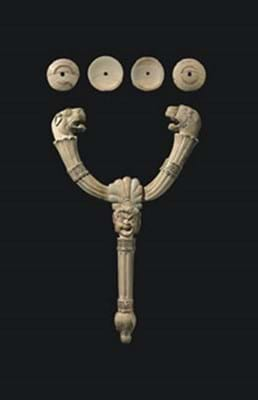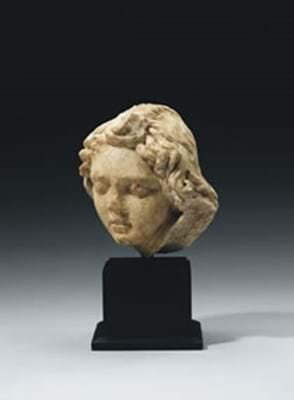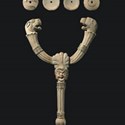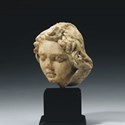There was, however, one notable exception, an Etruscan ivory sistrum dating to the 6th-4th centuries BC pictured on this page.
It had been purchased within the last few years by the vendor who had spotted it at a provincial auction in the north of England.
The musical instrument which had undergone conservation, had a carved fluted handle with grooved ribs that were embellished with raised collars and inlaid with fine gold wire. The handle was surmounted by two actor's masks; a comic face and a tragic face. Open-mouthed lions emerging from lotus flowers headed the curved arms of the instruments that would originally joined by circular discs threaded together. These would have vibrated to imitate the rustle of reeds.
Sistra are more readily associated with Ancient Egypt where bronze or wooden examples were shaken to appease the goddess Hathor. Etruscan sistra are more unusual and London's British Museum is thought to have the only other surviving ivory example.
This instrument may have formerly been in the Tristram FSA collection as it was sold in an auction house clearance together with other bronze objects with old collection labels. The collector may have been Ernest William Tristram (1882-1952), a painter and art historian and fellow of the Society of Antiquaries.
A dealer bidding on behalf of a client secured it in the room at £36,000.
Although few entries flew away, with buyers bidding selectively for the best quality reasonably estimated works, demand was more consistent for the Roman marbles. They included a 133/4in (35cm) high head of the Empress Livia dating to the 1st century BC to 1st AD portrayed as a young woman with soft skin and curving lips. She found a buyer at £30,000, while the decorative appeal of a Roman marble of sleeping Eros from the 1st century AD persuaded a non-specialist to bid an above-estimate £7800 for ownership.
Appealing more to academic buyers was an early 3rd century AD Roman marble stele from Asia Minor with a four-line dated Greek inscription. It sold to a European institution at £9000.
Etruscan rattles to a £36,000 tune
Bonhams Bond StreetCLASSICAL sculpture also dominated Bonhams wide-ranging mixed-owner sale on April 21. Led by the Hever nymph and satyr, discussed on page 13, Roman marbles accounted for eight of the ten highest prices.








